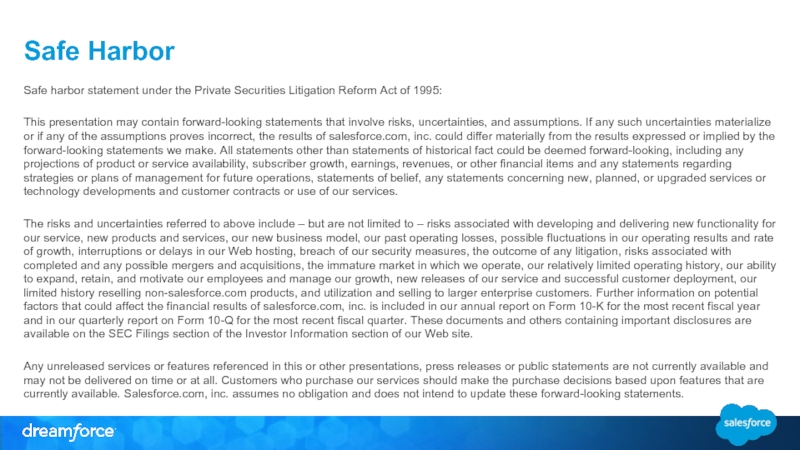Слайд 2Safe Harbor
Safe harbor statement under the Private Securities Litigation Reform Act
of 1995:
This presentation may contain forward-looking statements that involve risks, uncertainties, and assumptions. If any such uncertainties materialize or if any of the assumptions proves incorrect, the results of salesforce.com, inc. could differ materially from the results expressed or implied by the forward-looking statements we make. All statements other than statements of historical fact could be deemed forward-looking, including any projections of product or service availability, subscriber growth, earnings, revenues, or other financial items and any statements regarding strategies or plans of management for future operations, statements of belief, any statements concerning new, planned, or upgraded services or technology developments and customer contracts or use of our services.
The risks and uncertainties referred to above include – but are not limited to – risks associated with developing and delivering new functionality for our service, new products and services, our new business model, our past operating losses, possible fluctuations in our operating results and rate of growth, interruptions or delays in our Web hosting, breach of our security measures, the outcome of any litigation, risks associated with completed and any possible mergers and acquisitions, the immature market in which we operate, our relatively limited operating history, our ability to expand, retain, and motivate our employees and manage our growth, new releases of our service and successful customer deployment, our limited history reselling non-salesforce.com products, and utilization and selling to larger enterprise customers. Further information on potential factors that could affect the financial results of salesforce.com, inc. is included in our annual report on Form 10-K for the most recent fiscal year and in our quarterly report on Form 10-Q for the most recent fiscal quarter. These documents and others containing important disclosures are available on the SEC Filings section of the Investor Information section of our Web site.
Any unreleased services or features referenced in this or other presentations, press releases or public statements are not currently available and may not be delivered on time or at all. Customers who purchase our services should make the purchase decisions based upon features that are currently available. Salesforce.com, inc. assumes no obligation and does not intend to update these forward-looking statements.

Слайд 37B2B Recommendations
Map the customer journey. Of the 510 senior-level marketers surveyed,
37% had adopted the term customer journey into their overall business strategy, compared to 42% of B2C senior-level marketers.
Prioritize mobile strategy. There are already billions of smartphones in the world, but more importantly, those smartphones are creating hundreds of trillions of data points by the second. B2B marketers currently aren’t adopting mobile marketing strategies at a high rate (61% don’t plan to use SMS or location-based tracking for marketing, and 53% don’t plan to use push notifications).
Test new tools. Marketing automation, videos, content marketing, guided selling, and landing pages are the most effective channels and strategies that B2B marketers can leverage.
Слайд 38B2C Recommendations
Maintain a customer journey focus. B2C companies are on the
right path when it comes to the customer journey; more B2C companies than B2B are using the term “customer journey,” and their definitions of the customer journey included customer-centric concepts like path, experience, and customer.
Rely on SEO/SEM, content marketing, and email as the workhorses of B2C. These three channels ranked most effective for B2C marketing leaders among all digital channels.
Close the data integration gap. Sixty-five percent of B2C marketing leaders say they have only partially integrated customer data across the organization (between sales, ops, customer service, marketing, and so on).